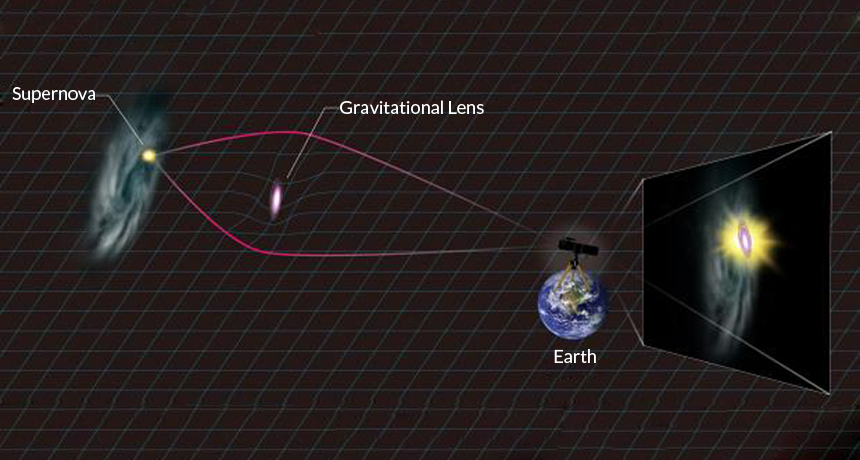
BRIGHT LIGHT The distant supernova PS1-10afx appeared 30 times as bright as it actually was because of the magnifying effect of a massive galaxy between it and Earth, as this illustration demonstrates.
Kavli IPMU
OXON HILL, Md. — An immense cosmic magnifying glass has given astronomers an unprecedented view of a distant exploding star. The discovery demonstrates that astronomers can spot supernovas that are seemingly too far away to be detected.
The supernova PS1-10afx, located more than 9 billion light-years away, first appeared in 2010 images from the Pan-STARRS1 sky survey. It shined about 30 times as brightly as a typical supernova at that distance. Last April, a team including astronomer Robert Kirshner from the Harvard-Smithsonian Center for Astrophysics published a study that classified PS1-10afx as a new type of ultrabright supernova.
But Robert Quimby, an astronomer at the Kavli Institute for the Physics and Mathematics of the Universe near Tokyo, was skeptical. He found that nearly every measurable characteristic of the supernova — including its color, temperature and duration of peak brightness — matched the profile of the most commonly found supernova, called type Ia. The only thing that set PS1-10afx apart was its extreme brightness.
Quimby wondered if something had made the supernova appear brighter than it actually was. He knew that the intense gravity of galaxies and other massive objects causes light to bend around them. If such a galaxy is positioned directly between a distant object and Earth, this light-bending effect can make the faraway object appear much brighter, analogous to the way a magnifying glass bends light to enlarge a faint object. This effect is called gravitational lensing.
To test his hypothesis, Quimby used the Keck I telescope in Hawaii to take a closer look at the region where PS1-10afx once shined. The telescope detected a large reservoir of gas about 8.5 billion light-years away. The gas suggested the presence of a galaxy lying between PS1-10afx and Earth that probably served as a gravitational lens. Quimby shared his findings January 8 at the American Astronomical Society meeting.
Kirshner said the Keck findings are convincing but not definitive. He would like to see more-detailed observations that demonstrate that the galaxy is massive enough and lined up properly to act as a lens.
Nonetheless, Kirshner is excited about the potential significance of Quimby’s work. Astronomers already use gravitational lenses to identify objects that would otherwise be too far or too faint to detect; a new Hubble Space Telescope survey is using the technique to find galaxies that formed a mere several hundred million years after the Big Bang. The opportunity to also spot distant supernovas with this technique is enticing, Kirshner said.
Quimby said that finding other distant stellar explosions could help astronomers measure the expanding universe. Type Ia supernovas shine with almost exactly the same brightness, allowing astronomers to pin a precise distance to each one. But a gravitationally lensed supernova’s light will travel slightly different distances depending on the path it takes as it bends around the lensing galaxy and thus will get stretched different amounts by the universe’s expansion.







